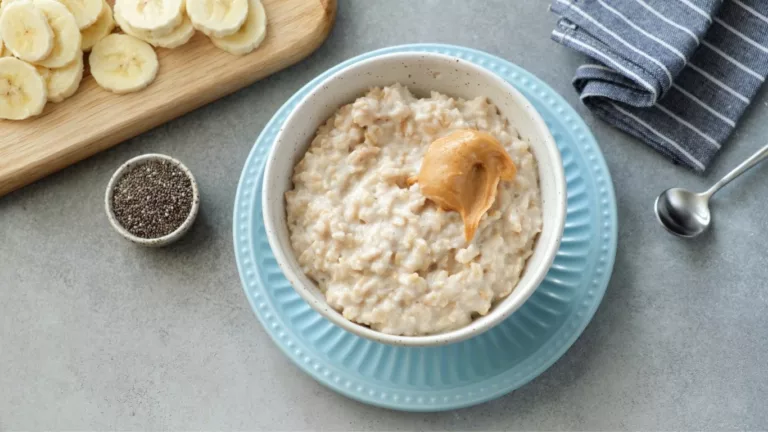Best GERD-Friendly Meal Planning Tips for a Heartburn-Free Life
Struggling with acid reflux and looking for GERD-friendly meal planning tips that actually work? I’ve been there—digging through conflicting advice, trying different foods, and learning the hard way which meals trigger those miserable flare-ups. The good news? Meal planning doesn’t have to be a guessing game. With the right approach, you can enjoy delicious, satisfying meals without the burn. Let’s dive into practical, expert-backed strategies to make eating with GERD easier and more enjoyable!
Understanding GERD and How Meal Planning Can Help

If you’ve been diagnosed with GERD (Gastroesophageal Reflux Disease), you already know it’s not just about heartburn. It’s that persistent discomfort, the regurgitation, the bloating—it can make eating feel like a chore. But here’s the thing: what you eat and how you eat play a massive role in managing symptoms.
Effective meal planning helps by:
- Preventing last-minute, poor food choices that can trigger reflux
- Ensuring you have safe, GERD-friendly foods on hand
- Encouraging balanced meals that support digestion
- Reducing stress around mealtime, which can worsen symptoms
So, let’s get into the nitty-gritty of making GERD-friendly meal planning simple and stress-free.
Essential GERD-Friendly Meal Planning Tips

1. Focus on Low-Acid, Easy-to-Digest Foods
One of the biggest mistakes I see people make (and trust me, I’ve made it too) is assuming that all “healthy” foods are GERD-friendly. Spoiler alert: they’re not. Tomatoes, citrus fruits, raw onions—these can be a nightmare for reflux sufferers. Instead, base your meals on:
- Non-citrus fruits: Bananas, melons, pears
- Non-starchy vegetables: Zucchini, green beans, carrots
- Lean proteins: Skinless poultry, fish, tofu
- Whole grains: Oatmeal, brown rice, quinoa
- Healthy fats: Avocado (in moderation), olive oil, nuts
2. Plan Small, Frequent Meals
Big meals are a reflux disaster waiting to happen. Ever noticed how symptoms spike after a heavy dinner? That’s because large meals put extra pressure on the lower esophageal sphincter (LES), making it easier for acid to creep up.
Instead of three large meals, aim for:
- Four to six smaller meals spread throughout the day
- Balanced portions of protein, healthy fats, and complex carbs
- Light evening meals to avoid nighttime reflux
3. Keep a GERD-Friendly Snack Stash
Let’s be real—hunger hits at the worst times. And when you’re starving, it’s tempting to grab whatever’s available, even if it’s reflux-triggering junk. I always recommend keeping a stash of GERD-friendly snacks handy. Some of my go-to options include:
- A handful of almonds (not too many—nuts are calorie-dense!)
- Whole wheat crackers with hummus
- Oatmeal with a drizzle of honey
- A banana with a spoonful of almond butter
4. Avoid Common GERD Triggers
Okay, this one’s tough, but it’s crucial. Some foods just don’t play nice with acid reflux. If you’re serious about meal planning for GERD, try cutting back on:
- Acidic foods: Citrus fruits, tomatoes, vinegar
- Fried & greasy foods: Burgers, fries, anything dripping in oil
- Carbonated drinks: Soda, sparkling water (yes, even the “healthy” ones)
- Caffeine & alcohol: Coffee, tea, wine—sadly, they’re common triggers
- Spicy foods: Hot sauce, jalapeños, anything that makes your mouth burn
I know—some of these might be your favorites. But trust me, cutting them out (or at least reducing them) can make a world of difference.
Setting Yourself Up for Success

5. Batch Cooking for GERD-Safe Meals
Life gets busy, and when you’re juggling work, family, and everything else, it’s easy to fall into the trap of ordering takeout. That’s why I swear by batch cooking. Prepping meals ahead of time means you always have safe, homemade options ready to go.
Some easy batch-cook meal ideas:
- Oatmeal packs: Pre-portion dry oats with cinnamon & flaxseeds
- Grilled chicken & quinoa: A simple, protein-packed meal
- Vegetable soup: Make a big pot and freeze portions
- Baked sweet potatoes: A great, digestion-friendly side
6. Smart Grocery Shopping for GERD
Having the right foods in your kitchen makes GERD meal planning effortless. Here are my golden rules for GERD-friendly grocery shopping:
- Stick to the outer aisles: That’s where the fresh, whole foods are.
- Read labels: Watch out for hidden acids and preservatives.
- Avoid processed foods: They often contain triggers like added sugar and fats.
- Buy in bulk: Stock up on safe staples like brown rice and lean proteins.
Taking a few extra minutes to plan your grocery list can save you from impulse buys that lead to GERD flare-ups.
Creating a GERD-Friendly Weekly Meal Plan

Alright, now that we’ve covered the basics of GERD-friendly meal planning tips, let’s talk about turning those ideas into an actual meal plan. If you’ve ever found yourself staring into the fridge at 7 PM, wondering what won’t set your esophagus on fire, you’re not alone. Trust me, I’ve been there. That’s why having a structured meal plan makes all the difference.
1. Start with Breakfast – Keep It Light and Soothing
Mornings set the tone for the rest of the day, and for those of us dealing with GERD, breakfast should be gentle on the stomach. Avoid acidic or greasy options (sorry, no greasy bacon or citrus smoothies here), and instead go for:
- Oatmeal with almond milk – A classic, fiber-packed option
- Scrambled eggs with whole-grain toast – Easy to digest and keeps you full
- Banana smoothie with oat milk – Creamy, delicious, and reflux-safe
- Greek yogurt with honey and almonds – A protein boost without acidity
2. Lunch – Balanced and Satisfying
By midday, you need a meal that fuels you without causing mid-afternoon reflux. I’ve learned the hard way that fast food and GERD do not mix, so I always pack my own meals. Some GERD-friendly lunch ideas include:
- Grilled chicken with quinoa and roasted veggies
- Turkey and spinach wrap on whole wheat
- Vegetable soup with whole-grain crackers
- Avocado toast with a poached egg (in moderation, since avocado is high in fat)
3. Dinner – Light but Nourishing
Dinner is where a lot of people slip up, eating too late or too heavy. I always aim for a meal that’s filling but doesn’t leave me regretting life at bedtime. A few of my go-to dinner choices:
- Baked salmon with steamed broccoli and brown rice
- Stir-fried tofu with zucchini and rice noodles (skip the spicy sauces!)
- Grilled chicken with mashed sweet potatoes
- Lentil soup with a side of whole-grain toast
Avoid heavy, spicy, or acidic meals in the evening. And remember—eating at least 2-3 hours before bed is a must to prevent nighttime reflux.
4. Hydration – What You Drink Matters
Most people focus on food when meal planning, but drinks can be just as tricky. I used to guzzle coffee like it was my job—until I realized it was making my reflux unbearable. Now, I stick to:
- Water – Always the best choice
- Herbal teas (like chamomile or ginger) – Soothing and caffeine-free
- Almond milk or oat milk – Great dairy alternatives
What to avoid? Coffee, carbonated drinks, citrus juices, and anything with artificial sweeteners.
How to Make GERD Meal Planning Easier

5. Meal Prep Like a Pro
Let’s be real—no one wants to cook every single meal from scratch. That’s why meal prepping is a lifesaver. Spend a couple of hours on the weekend prepping GERD-friendly meals, so you always have something safe to eat.
Some simple meal prep strategies:
- Cook grains in bulk – Brown rice, quinoa, and oatmeal keep well.
- Pre-cut veggies – Store them in airtight containers for quick meals.
- Make a big batch of soup – Freeze portions for later.
- Portion out snacks – Keep almonds, hummus, or whole-grain crackers ready to go.
6. Keeping a GERD-Friendly Kitchen
It’s way easier to stick to a GERD-friendly diet when your kitchen is stocked with the right foods. I always make sure I have:
- Lean proteins – Chicken, turkey, fish, tofu
- Whole grains – Brown rice, quinoa, oats
- Vegetables that don’t trigger reflux – Green beans, carrots, zucchini
- Healthy fats – Olive oil, avocado (in moderation), nuts
- Reflux-safe snacks – Oatmeal, whole-grain crackers, bananas
And let’s not forget the importance of having a solid plan for dining out, because let’s be honest—sometimes, you just don’t feel like cooking.
Dining Out with GERD: What to Order and What to Avoid
7. Tips for Eating Out Without the Burn
Eating out with GERD can feel like navigating a minefield, but it’s totally doable. Here’s what I’ve learned:
- Stick to grilled proteins – Choose grilled chicken, fish, or tofu.
- Avoid heavy sauces – Ask for dressings and sauces on the side.
- Say no to fried foods – Opt for baked, steamed, or roasted options.
- Watch portion sizes – Split your meal or take half home.
- Skip the carbonated drinks – Stick to water or herbal tea.
Oh, and one of the best tips? If you’re unsure about ingredients, don’t be afraid to ask your server. Most places are happy to accommodate dietary needs!
Case Studies & Real-Life Examples

Sometimes, the best way to understand how to manage GERD through meal planning is by hearing real-life experiences. Here are a few case studies that highlight the impact of dietary changes.
Case Study #1: Sarah’s Struggle with Late-Night Reflux
Sarah, a 35-year-old teacher, used to rely on takeout after long workdays. Her late-night fast-food meals led to severe nighttime reflux, making it impossible to sleep. After implementing a structured GERD-friendly meal planning approach—eating dinner earlier, swapping fried foods for grilled options, and reducing acidic beverages—her reflux improved dramatically.
Case Study #2: Mark’s Journey to a GERD-Free Life
Mark, a fitness coach, assumed his high-protein diet was the best for his health, but his daily black coffee, spicy chicken meals, and post-workout protein shakes triggered unbearable heartburn. After adjusting his plan to include GERD-friendly proteins (like grilled turkey and plant-based options) and switching from coffee to low-acid herbal tea, he saw a huge difference in just a few weeks.
Case Study #3: Emma’s Smart Snacking Strategy
Emma, a busy mom, found herself snacking on chips and chocolate between meals—both major reflux triggers. By switching to snacks like almonds, whole-grain crackers, and banana slices, she was able to keep hunger at bay without the burn.
Key Takeaways: What You Need to Remember
By now, we’ve covered a ton of ground on meal planning for GERD. Let’s quickly recap the most important points:
- Choose the right foods: Stick to lean proteins, whole grains, and non-acidic vegetables.
- Time your meals wisely: Avoid eating at least 2-3 hours before bed.
- Avoid common triggers: Say no to fried foods, spicy meals, coffee, and carbonated drinks.
- Hydrate smartly: Water, herbal teas, and non-dairy milk are your best friends.
- Plan ahead: Meal prepping and grocery planning make sticking to a GERD-friendly diet much easier.
FAQs
Q: Can I still enjoy coffee with GERD?
A: Unfortunately, coffee is highly acidic and a known GERD trigger. If you can’t quit cold turkey, try switching to low-acid coffee or decaf herbal teas like chamomile or ginger.
Q: Is it okay to eat dairy?
A: That depends! Full-fat dairy can be a trigger, but low-fat options like Greek yogurt or almond milk are usually better tolerated.
Q: How can I prevent acid reflux at night?
A: Stick to an early dinner, avoid lying down immediately after eating, and consider raising the head of your bed slightly to prevent acid from creeping up.
Bonus: Additional Resources & DIY Tips
Free Meal Planning Template
Need help organizing your GERD-friendly meals? Download a free meal planning template to make your weekly prep a breeze!
DIY GERD-Friendly Recipe Swaps
Simple ingredient swaps can make a huge difference. Here are some of my favorites:
- Instead of white bread → Choose whole grain
- Instead of frying → Try baking or grilling
- Instead of acidic dressings → Use olive oil and herbs
- Instead of soda → Drink infused water with cucumber or mint
Support Groups & Communities
Managing GERD is easier when you’re not doing it alone! Join online support groups or forums where you can share meal ideas and get advice from others facing the same challenges.
Appendix
References
- National Center for Biotechnology Information (NCBI) – Research on GERD and dietary impact.
- Mayo Clinic – Guidelines on managing acid reflux.
- Heartburn Alliance – GERD-friendly food lists and tips.
Disclaimer
The information provided in this article is for educational purposes only and should not replace medical advice from a healthcare provider. Always consult with a doctor or registered dietitian before making major dietary changes.
Call to Action
Struggling with GERD and looking for more meal ideas? Subscribe to my newsletter for weekly GERD-friendly recipes, expert tips, and exclusive resources to help you enjoy food without the burn!
Have a GERD-friendly recipe or tip to share? Drop it in the comments below—I’d love to hear from you!

Camellia Wulansari is a digestive health writer at Healthusias, known for turning complex gut-related topics into clear, relatable insights. Her passion lies in helping readers understand and manage conditions like acid reflux, GERD, bloating, and indigestion—using a mix of research-backed strategies and real-life solutions.
With years of experience writing in the health space, Camellia dives deep into the causes, symptoms, and lifestyle triggers of digestive issues. She’s especially focused on helping people identify food-related sensitivities, manage reflux naturally, and build daily habits that support long-term gut wellness.
Her mission? To make digestive health feel less overwhelming—and a lot more manageable.
Explore Camellia’s latest articles on Healthusias for down-to-earth advice and practical tips to help your gut (and life) feel a whole lot better.







